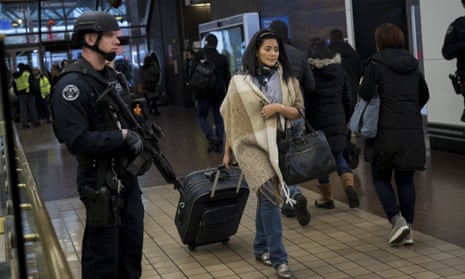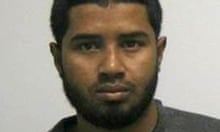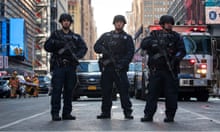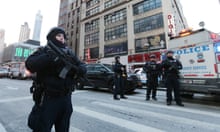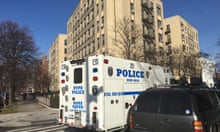Every weekday, nearly 5.7 million people move through New York City’s subway system, commuting through 472 subway stations and across 662 miles of track.
Monday’s attempted bomb attack struck at the heart of the commuter network in the Monday morning rush hour. Officials said the bomb detonated in a subway passageway in midtown Manhattan, between Port Authority bus terminal, which itself serves 65 million passengers each year, and the Times Square subway station at 42nd Street.
What New York’s mayor dubbed an “attempted terrorist attack” comes nearly three months after a morning attack on the London Tube in September, which left 29 people injured after a bomb inside a train carriage partially detonated.
New York police commissioner James O’Neill said after Monday’s attack: “We have almost 3,000 transit cops. All parts of the system are patrolled.” However, a highly visible security presence cannot provide absolute protection.
American counter-terrorism experts have long warned that, compared to the heavy security and screening regimens at airports, trains and commuter rail systems are comparatively vulnerable to attack. This summer, an al-Qaida propaganda outlet reportedly released a guide to derailing trains and attacking rail systems, which included a list of popular American train routes, including the Acela Express line through Boston, New York, and Washington.
TimelineMajor terror attacks in the US
Show
Hesham Muhammad Hadayet, an Egyptian national with a green card giving him permanent status in the United States, killed two people and wounded four at Los Angeles International Airport. Hadayet also died.
Abdulhakim Mujahid Muhammad, an American-born convert to Islam, opened fire on an army recruiting office in Little Rock, Arkansas. Muhammad killed one soldier and wounded another. Muhammad, who previously lived in Yemen, claimed to be a member of al-Qaida. Muhammad eventually pled guilty to avoid the death penalty.
Army major Nidal Hasan opened fire in the Soldier Readiness Processing Center at Fort Hood, Texas. The American-born Hasan killed 13 soldiers and wounded 32. Hasan was paralyzed in the attack. At his trial, he declared himself to be at war with America and investigators found that although he acted alone, he had accessed jihadist websites. Hasan was sentenced to death and is currently incarcerated in Fort Leavenworth, Kansas.
The Boston Marathon attack was carried out by two brothers, Dzhokhar and Tamerlan Tsarnaev. The bomb killed three people and injured 264. The two later killed an MIT police officer. In addition, in a firefight between the brothers and the police, 16 officers were injured and another later died. Tamerlan died after he was shot by police and his brother ran over him in a car in an attempt to escape. Dzhokhar was apprehended and sentenced to death. The two Kyrgyz-American immigrants had been self-radicalized but learned to make their bomb from the al-Qaida online magazine Inspire.
Muhammad Youssef Abdulazeez attacked a marine recruiting office and US Navy reserve center. He killed four marines and one seaman before police killed him. Abdulazeez was an American citizen born in Kuwait. Former FBI director James Comey said Abdulazeez was “motivated by foreign terrorist organization propaganda.”
Syed Rizwan Farook and Tasheen Malik opened fire at the San Bernandino County Department of Public Health. Fourteen people died and 24 were injured. Farook was born in the United States and Malik was a Pakistani immigrant. The two were killed by police. The FBI described them as “homegrown violent extremists”.
American-born Omar Mateen killed 49 people and wounded 58 at the Pulse nightclub in Orlando, Florida. In calls made during his rampage, Mateen pledged allegiance to Isis. He was killed by police.
A man drove a truck into people on the Hudson River bike path, killing eight and injuring 11. Sayfullo Saipov, a 29-year-old immigrant from Uzbekistan, has pleaded not guilty to murder.
Commuter rail lines and long-distance trains are “both vulnerable,” said Colin Clarke, a political scientist and counter-terrorism expert at the Rand Corporation. “You don’t get searched getting on to either. There’s no screening system.”
Train commuters have long been terror targets. The 1995 sarin gas attack on the Tokyo subway left 13 people dead and injured 6,000 others. The terror attack was carried out by a doomsday cult. In 2004, jihadists carried out a series of coordinated bombings on Madrid’s crowded commuter trains, which left 191 people dead and nearly 2000 injured. In 2005, suicide bombers in London killed 52 people and injured hundreds.
In 2015, an attacker wielding an AK-47 opened fire on a high-speed train from Amsterdam to Paris, but was disarmed by three US citizens, two of them soldiers, before killing anyone.
It’s unlikely that daily commuters would accept more intensive, airport-style screening procedures unless there was another major, successful attack, Clarke, the counter-terrorism expert, said, and even then, searching every single person before they boarded public transit systems would likely be unrealistic.
Some public metro system are moving towards mass screening. Shanghai’s metro now screens passenger bags and other carry-ons, said Anastasia Loukaitou-Sideris, a transit security expert at the urban planning department of the University of California Los Angeles. “There was not much of a delay,” she said.
Shanghai’s metro system serves 3.4 billion riders a year compared with New York City’s 1.8 billion, according to statistics compiled by New York’s transit system. High-speed rail lines in Europe do similar baggage screening, Loukaitou-Sideris said.
Since transit operators often argue that intensive screenings will lead to unacceptable delays, officials have instead pursued better security through environmental design, like choosing construction materials that are shatter-resistant and non-combustible, or removing trash cans where bombs might be stored, as Tokyo did after its attack, she said.
Researchers also found that information-sharing between different American agencies to prevent attacks improved in the decade since the London bombings, Loukaitou-Sideris said.
In the United States, the deadliest attack on public transit was carried out not by jihadists with bombs, but by a mass shooter, “a mentally disturbed individual who killed six and wounded another 19 passengers aboard a Long Island commuter train in 1993,” according to a January 2016 report by the Mineta Transportation Institute at San Jose State University in California. “ ‘Lone loons’ rather than ‘lone wolves’ continue to be the threat in North America,” the report’s authors wrote.
Recent attacks have left commuters on edge. In November, a fight between two men at London’s Oxford Circus tube station sparked a mass panic among riders after they heard screams and saw others running and thought an attack was taking place. Patrons hiding in a basement at an Italian restaurant near the station burst into applause when a waiter announced there had been no terrorist incident.
